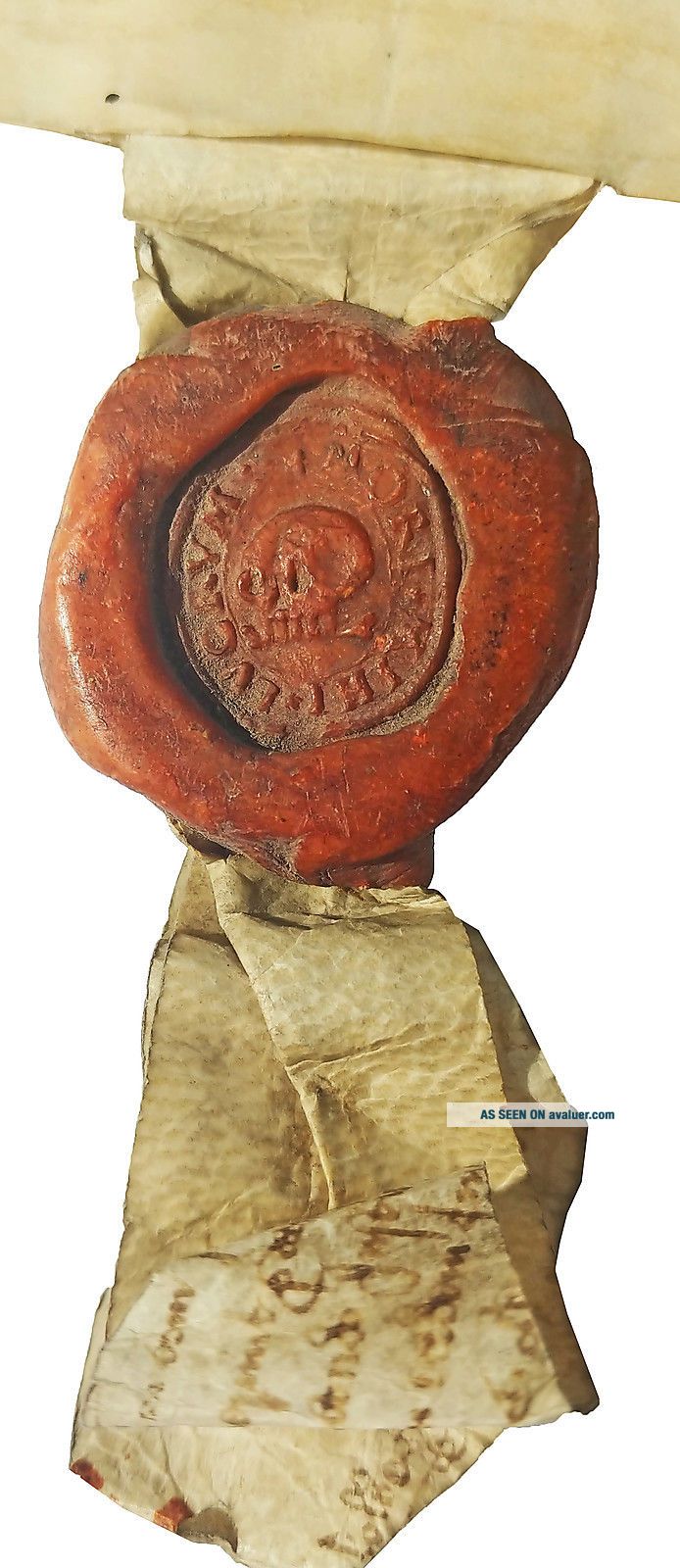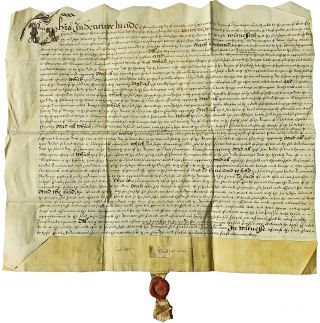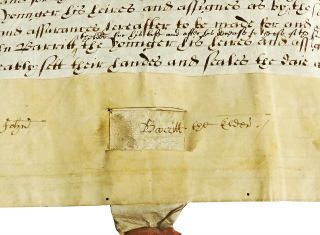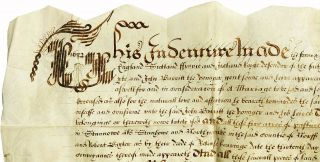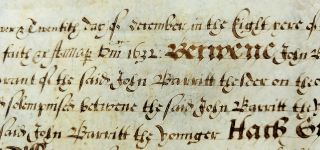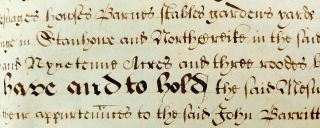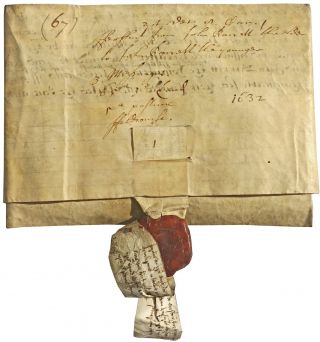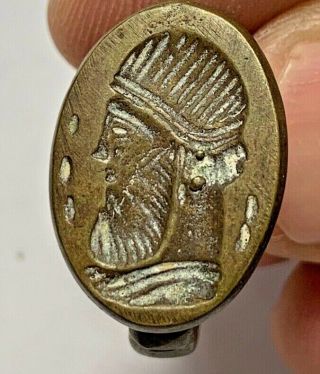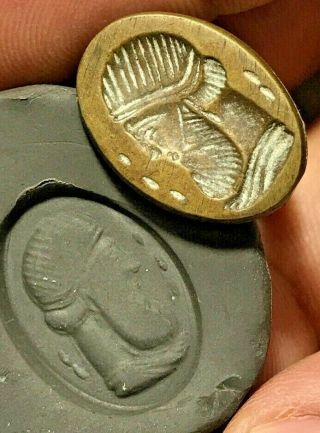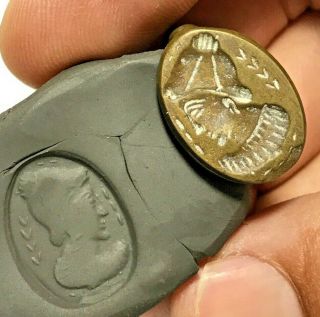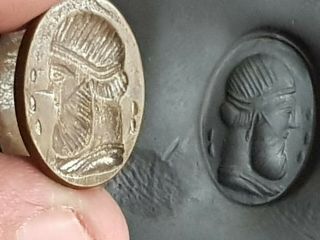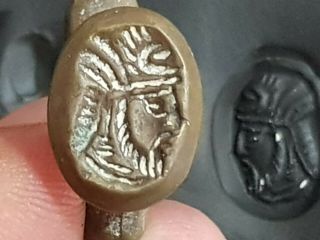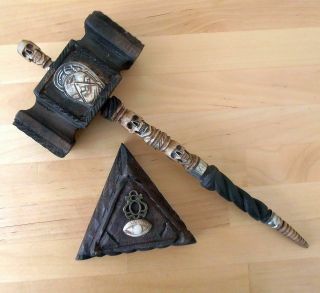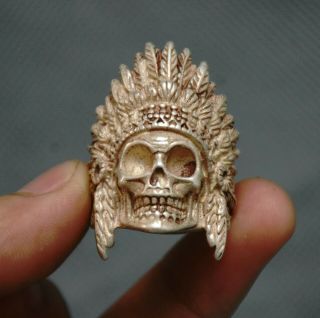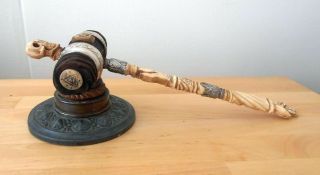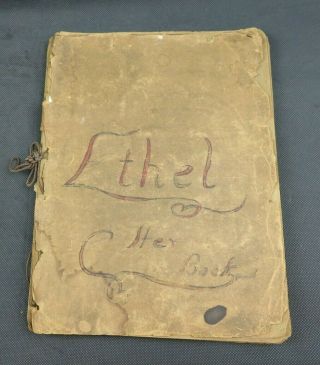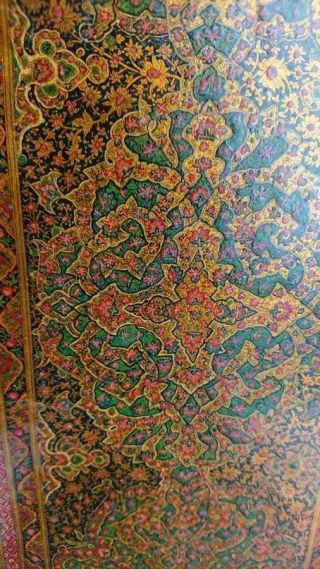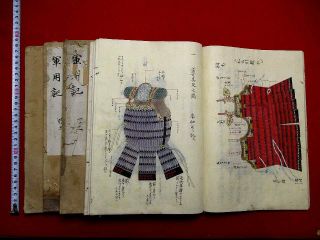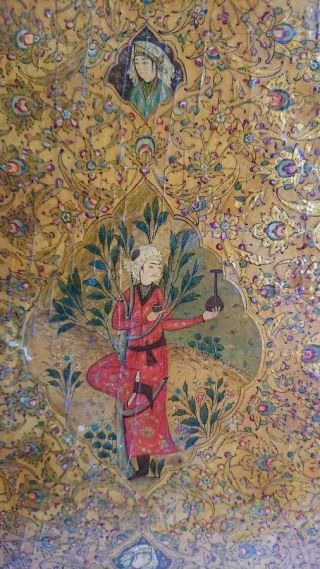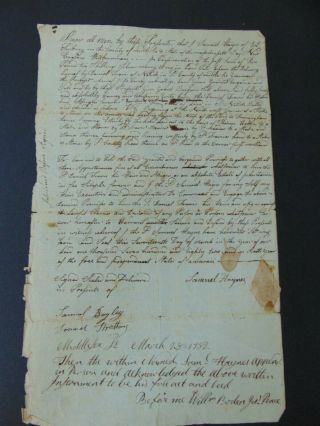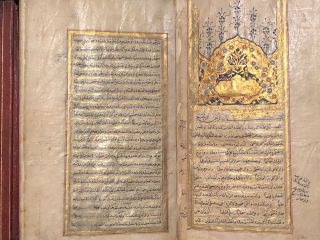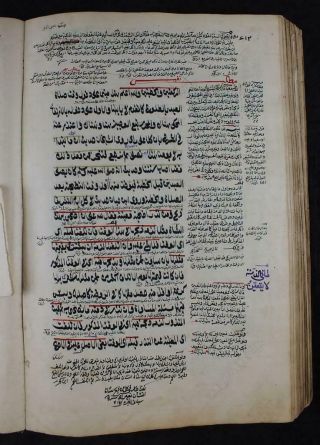1632 Indenture - SKULL HEAD SEAL - KINGS LYNN - Captain Vancouver Birthplace
Item History & Price
| Reference Number: Avaluer:2009 | Original/Facsimile: Original |
Feoffment Land Conveyance
Manuscript Indenture on Vellum
Wax Seal with Human Skull Motif
1632
Barwick in King's Lynn District
Birthplace of
Captain George Vancouver
Pacific Navigator
Barwick [in the district of King's Lynn, Norfolk], 24 December 16...32. Unique and early manuscript indenture on vellum, concerning multiple feoffment lands and messuages belonging to John Barritt of Barwick, Norfolk, 65 acres combined in medieval terms, situated in Barwick, Stanhoe, and North Creake, being granted to his son under the circumstance of marriage. Features a most unusual wax seal with a religious Latin motto and imagery of a human skull. Text is in English, including manuscript docketing to verso. Document measures approximately 48 x 42 cm, with wax seal affixed to a vellum pendant which features diminutive manuscript writing possibly in Latin. Some age-toning, otherwise in very good condition, with a unique wax seal, John Barritt the elder's original signature, beautifully preserved, a fascinating surviving land title document from seventeenth century England. A superb surviving record of early Norfolk land ownership, this is an exceptionally scarce and therefore historically significant document. The lands being dealt with and changing hands with this document are in the district presently known as King's Lynn and West Norfolk. According to the indenture, the region was referred to as the County of North Fiefdoms of Norfolk in the seventeenth century.Barwick is a civil parish in the district of King's Lynn and West Norfolk, some 30 miles from the seaside village of King's Lynn which would later be the birthplace of Captain George Vancouver the great navigator of Pacific Northwest America fame.
A rare primary source document, contemporary to the earliest of Norfolk genealogy parish records, the transaction recorded herein reveal details of land conveyance, inheritance by birth right, vassal holdings, and early lineages in the parishes of Barwick, Stanhoe, and North Creake. Information is scant at best for Barritt ancestry, which is also seen as Barrett, and even sometimes Barwick. Geneologies record some of the Barritt lineage in Northampton and Norfolk back to the 1730s. Records of births, marriages and deaths were kept by the government from July 1837 to the present day. The 11th century church of St Michael in Flordon, holds genealogy parish registers of christenings, marriages and burials from as early as 1559 and bishop's transcripts from 1698. This land indenture, made in 1632, included multiple enfeoffments and at least three messuages, situated in Barwick, Stanhoe, and North Creake, in the ancient Hundred shire of Docking, Norfolk, which suggests that John Barritt the elder was a wealthy Lord. Manuscript docketing annotations to verso summarize the substantial gift as 3 messuages, 65 acres and 3 roods of land, 5 acres of pasture, and feoffments. In subsequent years, he is known to have held significantly more holdings, almost doubling the estate described here. The wax seal on the 1632 document is most unusual, being a human skull motif surrounded by the words "mori mihi lucrum." The Latin text "mors mihi lucrum" means "death to me is reward", being a common epitaph, from St Paul's Epistle to the Philippians, in full "Mihi enim vivere Christus est et mori lucrum", which is translated in the King James Bible as, "For to me to live is Christ and to die is gain.") A further unique quality with this indenture, is that land is being conveyed while the feudal lord was still living, the latter presenting his son, John Barritt the younger, a gift of inheritable lands at the time of marriage. As such, it is reasonable to presume that the estate comprised even more than what is described here. [Land indentures from this period are scarce in any format, however most are postmortem conveyances of inheritance. This situation is scarcely seen.]
Signed by John Barritt the Elder:
Following are some excerpts from the indenture, highlighting some of the parties involved, the regions in Norfolk, and aspects of feudal law in England:
"This indenture made the fourth & twentith day of December, in the first year of the Reigne of our Soveriegne Lord Charles by the grace of God, of England, Scotland, France and Ireland defender of the faith... 1632"
"Betweene John Barritt of Barwicke in the Countie of North Fiefdom person gent [gentleman] one the one pte [part]..."
"and John Barritt the Younger gent [gentleman]... heir apparent of the Said John Barritt the elder on the other pte [part]."
"Witnesseth that the Said John Barritt the elder in confidence of a marriage to be had... between the Said John Barritt the Younger and Elizabeth Syday daughter of Robert Syday clerke deceased & also for the naturall love and affection she beareth toward the Said John Barritt the Younger"
"Has Granted infeoffed and confirmed and by the... doth grante... to the Said John Barritt the Younger and his heirs..."
"All that Messuage with the Barnes buildings & stables gardens yards and outeryards to the same... and all feof five acres of pasture and sixteen acres of land... of William Baxter & Robert Baxter... in Stannowe at Stanhowe and Northcreake... and..."
"... which John Barritt grandfather of the Said John Barritt the Younger lately purchased of the Said Willm [William] and Robert Baxter as by their deed of Release bearing date the thirteenth day of Januarie in the eight and twentith year of the Reigne of Elizabeth late Queen of England [1586] and by other conveyances made..."
"... all those generall peeces of land... and halfe a roode with their appurtenances lyenge [lying] in the North feifs of Barwick aforesaid."
"... And all that once acre and a halfe of land lyening in Stanhowe [Stanhoe], abovesaid in a furlong called Roughsands which the said John Barritt grandfather late purchased of William Baxter as by a deed of feoffment bearing the date sixtenth day of March in the fourteenth yearof the Reigne of Elizabeth late Queen of England [1572]... "
"And all that Forfeiture of land... with appurtenances lyeing in Stanhowe aforesaid next a lane called Petergate Lane which the said John Barritt the grandfather lately had to him and his heirs the feoffment of Symon Maynford and Margaret his wife bearing date the two and twentith day of September in the fortith year of the Reigne of our said late Queen Elizabeth [1598]...." [Petergate Lane was connected to the Church of All Saints in Stanhoe, Norfolk, which is believed to have been linked to Procession Mile and part of the route for the ceremony of beating the bounds.]
"... five Roods of land lyenge in Stanhowe... purchased of Edward Hampton clerk... the thirtith day of September in the fiftenth year of the Reigne of the said late Sovereigne Lord Kinge James [1582]..." [There was an Edward Hampton who was rector of the Church of All Saints in Stanhoe, Norfolk thirty years later, in 1612, according to parish records signed by him in 1637.]
"And all other the freehold and charterhold Messuages & lands & tenements and hereditaments of the Said John Barritt the elder...."
"In witness... Indentures have past ynterchangeably the handes and seales per... first above written."
End Excerpts.
In the Middle Ages, especially under the European feudal system, feoffment or enfeoffment was the deed by which a person was given land in exchange for a pledge of service. This mechanism was later used to avoid restrictions on the passage of title in land by a system in which a landowner would give land to one person for the use of another. Following are some other examples of the now archaic terms used in the present document:
'Rood' was a measure of land area, equal to a quarter of an acre. The rood was an important measure in surveying on account of its easy conversion to acres.
'Acre' was a measure of land back in medieval days, though rather vaguely attributed and certainly subjective, being an area of land that could be ploughed by a one-ox team in a single day.
'Forfeiture' is the right of a feudal lord to recover a fief when a vassal failed to honour his obligations under the feudal contract.
'Fiefdom' (fief, feoff) was an estate controlled by a feudal lord or a vassal, often in return for stipulated services, chiefly military.
'Enfeoff' - To take someone into vassalage where they will render a certain service in return for a fee or fief.
Feudalism as practiced in the Kingdom of England was a state of human society which was formally structured and stratified on the basis of land tenure and the varieties thereof. Society was thus ordered around relationships derived from the holding of land, which landholdings are termed "fiefdoms, fiefs, or fees". These political and military customs existed in medieval Europe, having developed around 700 A.D., flourished up to about the first quarter of the 14th century, and declined until their legal abolition in England with the Tenures Abolition Act 1660. Under the English feudal system, the person of the king was the only absolute "owner" of land. All nobles, knights and other tenants, termed vassals, merely "held" land from the king, who was thus at the top of the "feudal pyramid". When feudal land grants were of indefinite or indeterminate duration, such grants were deemed freehold, while fixed term and non-hereditable grants were deemed non-freehold. However, even freehold fiefs were not unconditionally heritable--before inheriting, the heir had to pay a suitable feudal relief.



